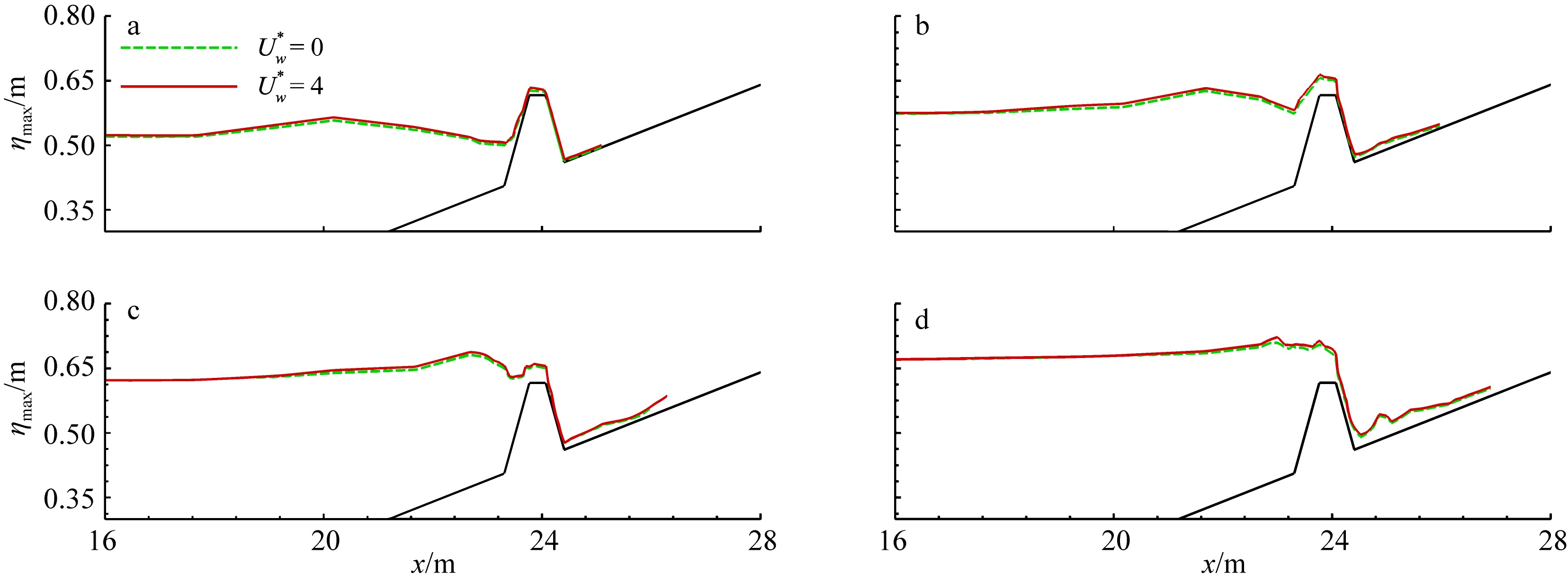Journal of Tropical Oceanography ›› 2023, Vol. 42 ›› Issue (6): 63-73.doi: 10.11978/2023033CSTR: 32234.14.2023033
• Marine Hydrology • Previous Articles Next Articles
Numerical simulation study of the influences of onshore wind on overtopping characteristics of coastal seawall under focused wave
ZHANG Liangbin1( ), QU Ke1,2,3(
), QU Ke1,2,3( ), HUANG Jingxuan1, WANG Xu1, GUO Lei1
), HUANG Jingxuan1, WANG Xu1, GUO Lei1
- 1. School of Hydraulic Engineering, Changsha University of Science & Technology, Changsha 410114, China
2. Key Laboratory of Dongting Lake Aquatic Eco-Environmental Control and Restoration of Hunan Province, Changsha 410114, China
3. Key Laboratory of Water-Sediment Sciences and Water Disaster Prevention of Hunan Province, Changsha 410114, China
-
Received:2023-03-14Revised:2023-04-23Online:2023-11-10Published:2023-04-26 -
Supported by:National Key Research and Development Program of China(2022YFC3103601); National Natural Science Foundation of China(51839002); The Natural Science Foundation of Hunan Province, China(2021JJ20043)
Cite this article
ZHANG Liangbin, QU Ke, HUANG Jingxuan, WANG Xu, GUO Lei. Numerical simulation study of the influences of onshore wind on overtopping characteristics of coastal seawall under focused wave[J].Journal of Tropical Oceanography, 2023, 42(6): 63-73.
share this article
Add to citation manager EndNote|Reference Manager|ProCite|BibTeX|RefWorks
Tab. 1
Parameter setup of numerical simulation"
| 工况 | U*w | HS/m | AC/m |
|---|---|---|---|
| A1 | 0 | 0.171 | 0.117 |
| A2 | 2 | 0.171 | 0.117 |
| A3 | 3 | 0.171 | 0.117 |
| A4 | 4 | 0.171 | 0.117 |
| A5 | 5 | 0.171 | 0.117 |
| A6 | 6 | 0.171 | 0.117 |
| B1 | 0 | 0.125 | 0.117 |
| B2 | 4 | 0.125 | 0.117 |
| B3 | 0 | 0.150 | 0.117 |
| B4 | 4 | 0.150 | 0.117 |
| B5 | 0 | 0.200 | 0.117 |
| B6 | 4 | 0.200 | 0.117 |
| C1 | 0 | 0.171 | 0.167 |
| C2 | 4 | 0.171 | 0.167 |
| C3 | 0 | 0.171 | 0.067 |
| C4 | 4 | 0.171 | 0.067 |
| C5 | 0 | 0.171 | 0.017 |
| C6 | 4 | 0.171 | 0.017 |
| [1] |
doi: 10.1115/1.4036206 |
| [2] |
|
| [3] |
|
| [4] |
|
| [5] |
doi: 10.1061/(ASCE)WW.1943-5460.0000234 |
| [6] |
doi: 10.1016/j.apm.2014.04.038 |
| [7] |
|
| [8] |
|
| [9] |
doi: 10.1080/00221686.2010.542616 |
| [10] |
doi: 10.1016/0021-9991(86)90099-9 |
| [11] |
|
| [12] |
doi: 10.3390/w12030686 |
| [13] |
doi: 10.1038/nclimate2124 |
| [14] |
doi: 10.1016/j.coastaleng.2019.103531 |
| [15] |
doi: 10.1017/S0022112007009019 |
| [16] |
|
| [17] |
doi: 10.1016/j.coastaleng.2021.104062 |
| [18] |
|
| [19] |
doi: 10.1061/(ASCE)0733-950X(1989)115:5(649) |
| [20] |
|
| [21] |
|
| [22] |
doi: 10.1007/s11804-018-0041-5 |
| [23] |
doi: 10.1016/j.apor.2017.07.015 |
| [24] |
doi: 10.1016/j.oceaneng.2009.07.011 |
| [25] |
|
| [26] |
doi: 10.1016/j.coastaleng.2014.08.007 |
| [27] |
doi: 10.2514/3.8284 |
| [28] |
doi: 10.1063/1.2890474 |
| [29] |
doi: 10.1016/0029-8018(95)00013-B |
| [30] |
doi: 10.1016/j.oceaneng.2022.113100 |
| [31] |
doi: 10.1016/j.apor.2004.01.004 |
| [32] |
doi: 10.1016/j.ijnaoe.2016.09.002 |
| [33] |
|
| [34] |
doi: 10.3390/en12183482 |
| [1] | WANG Xu, QU Ke, WANG Zijun, YANG Yuanping, WANG Chao, ZHANG Liangbin. Numerical simulation study on the effect of wind on the hydrodynamic characteristics of undular tidal bores seawall [J]. Journal of Tropical Oceanography, 2024, 43(5): 116-130. |
| [2] | GAO Rongze, QU Ke, REN Xingyue, WANG Xu. Application of convolutional neural network methods in the evolution of hydrodynamic characteristics of tsunamis like-wave over fringing reef [J]. Journal of Tropical Oceanography, 2024, 43(4): 68-75. |
| [3] | LI Junjie, QU Ke, WANG Xu. Three-dimensional numerical simulation of the influence of excavation pit on the hydrodynamic characteristics of solitary wave on fringing reef [J]. Journal of Tropical Oceanography, 2023, 42(6): 42-51. |
|
||







































